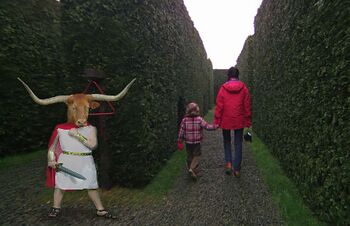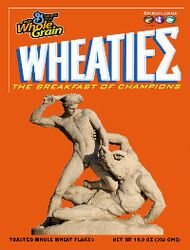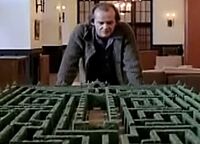Minotaur
The Minotaur is a half-human, half-bull creature in Greek mythology. Rather than a domestic cow, the bovine parent was an auroch, now extinct, as opposed to an auror, which is hoped to be extinct. The tale is probably a manifestation of man’s historic fascination with cow sex. The odd combination of species stands as proof of Creationism, though not by the usual expected deity.
The monster's given name was Asterix, suggested by some visiting Celts from Gaul.
The beast is typically described in painting and sculpture as having a human body and a bull's head. Some writers have described him the other way around. Considering the combinations possible, it is a wonder that the Minotaur didn't end up as an amalgamation of two different butts.
Experts in Greek mythology suspect that if the minotaur were born female, then the Borden's company would have adopted its mascot and symbol much, much earlier. The storyline would also then have been much different. Historians agree that the tale would have ended up as some sort of lesbian fanfic, which is within the canon of the soap opera that is Greek mythology.
The Minotaur is entirely responsible for You have two cows in the modern age.
Early Life[edit]
The Minotaur was the result of the union of a sacred bull and Pasiphaë, wife of Cretinous King Minos. She was magically compelled to mate with the bull by the god Poseidon, who was punishing the royal family for not eating fish on Fridays. Pasiphaë then had to cover up her liaisons by explaining that she was "going to cow church".[1] Minos was pleased that she was honoring the sacred bull, while unaware that he was getting the usual bull. Upon seeing the resultant baby, a furious King Minos suspected a Viking father until an adviser told him that (α) horns on their helmets were a myth, and that (β) Vikings wouldn't be along for a couple thousand years yet. Satisfied, he accepted the child as his own.
Junior (as his mother would call him) proved to be a problematic child. He gored two wet nurses, and even highly recommended nanny Mara Poppinopoulos was unable to control the young Minotaur.
Thus it was decided to send him to a military boarding school. His grades were fairly miserable with a Δ average, though he did regularly receive an Α in violent deportment.[2]
After Junior made a disastrous school trip to a china shop, the king finally resigned himself to the fact that Junior was out of his control. Minos commanded Daedalus to build a complex maze where the Minotaur could be kept safely. This was to be called the Labyrinth.[3] Members of the School of Cynics doubted whether this was good choice since Daedalus didn’t do a very good job on son Icarus’s wings. Nonetheless, the project was completed on time and on budget, a now-lost art.[4] Costs were probably kept down since the Labyrinth was so confusing, no worker ever managed to find the exit, thus reducing labor costs tremendously.
The Minotaur was placed in a room at the center by the royal "Minos's Minister Minions". They made sure to spin him around a few times to confuse him, then ran like hell. This event would be recorded and celebrated forever in the Olympic 100 meter dash.
Various writers reported that Crete's defeated enemy Athens had to provide children to feed the Minotaur. This was done at intervals stated to be yearly to several years apart. The minotaur otherwise survived on breakfast cereal and fast food thrown into the maze. This showed that the monster’s roots were not forgotten, as this was food befitting royalty at the time.
Encounter with Theseus[edit]
Young Theseus, the son of the king of Athens, became irritated that he no longer had very many kids his own age to hang out with. As befitted a callow youth who would deny his lack of popularity due to his own failures,[5] he demanded his father tell him where the other kids on the block had gone.[6] King Aegeus explained the need to sacrifice his son’s peers to the monster. Realizing that females were included, Prince Theseus resolved something had to be done if he was to get any, unless he somehow overcame his revulsion of screwing cows. Then and there, the young man decided that the minotaur had to go.[7]
Theseus did not mess around. He hired the respected Garmin of Thebes to guide him through the maze. Garmin led the prince through the maze, speaking in even, measured tones. So calming was the guide’s voice, that the future hero did not realize where they were until he looked up and saw the street signs at the intersection of Center and Mays in Cairo (Illinois). Puzzled, Garmin realized a temporary construction zone in the labyrinth had rerouted them and got them lost. Uttering his now-famous quote, the old guide quipped, "I guess we should have taken a left at Albuquerque." An angry Theseus struck off Garmin's head with one blow.
Now without a guide, quick-thinking Theseus bought two balls of twine and proceeded to mark his return path by unrolling the twine as he progressed through the maze. Soon enough, he reached the end of the second ball. He was unaware of being tracked by Athena, who was having a good laugh about all this so far. So she magically directed two youths who had escaped[8] the minotaur toward Theseus. They were Hanseleus and Gretelea, who, failing to find any bread, were leaving a trail of corn flakes from a found box so they would not backtrack. Surprising each other, they quickly realized they both had what the other needed. The fortuitous meeting provided Theseus with a much needed snack of the remaining corn flakes in the box.
He followed the trail until he came upon a flock of pigeons that had eaten enough corn flakes to destroy the trail. Theseus reddened in anger as he heard hooting[9] and raucous laughter from the direction of Mt. Olympus. With one blow he struck off the heads of the pigeons. Stymied,[10] he began to wander in the twisting maze of little passageways, all alike.[11]
Meanwhile, the Minotaur was also wandering through the maze, looking for his escaped dinner. Just as Theseus was using his cudgel to (incorrectly) point out the exit to a Korean tour group, the minotaur came around a corner, running into the stick and knocking himself out. Theseus quickly seized the Minotaur’s sword and slew him by[12] striking off his head. The tour group applauded, thinking this was some Minoan version of Benihana. They were soon joined by escapees formerly on the minotaur’s menu. With even more pairs of eyes now available, they were able to pick up the trail to the exit.
Upon exiting, Theseus noticed a standing man. The man was selling Labyrinth cheat codes for 35 shekels. Now absolutely outraged, Theseus not only struck off his head, but chopped him into little pieces. The Benihana idea was further reinforced in the minds of the tour group. One of the escapees, named Ariadne, immediately fell in love with Theseus after all the excitement.
The gods reconstituted the man, named Prometheus, in reality a Titan (TE, 1961-1962). They still punished him for copyright violation. Prometheus was condemned to be chained to a rock for all time, while his liver was diced up by a Benihana chef.[13] The pieces are fed to the eagles from Lord of the Rings. The cycle is repeated for each tram passing through on MountOlympusLand’s[14] most popular ride, Labyrinth Mountain.[15]
On the trireme ride back to Athens, Theseus figured that he was ditched by Ariadne and some of the cooler kids who said they were going to the mall in Naxos. Dejected, the youthful hero set sail for Athens. In reality, the group went searching for a Korean place in food court #2 that they heard had really good bulgolgi. They took a wrong turn down a service corridor and were eaten by a grue.
Theseus had prearranged a return signal for his impatient father, King Aegeus. If the hero’s ship showed white sails, it would show that Theseus was triumphant. If black sails were shown, it would mean that he was killed or turned Goth. However, as Theseus was preoccupied with mounting the minotaur's horns on the front of his trireme, he commanded a passing sailor to set the sails. The rather simple sailor just grabbed the first sails he could, which happened to be red, and ran them up.
Seeing that from afar, King Aegeus was completely confused. The ruler decided to take a 3-hour cruise with his wife on the bireme ψαράκι to clear his head while waiting for his son. The couple, three passengers and two crewmen were never heard from again. Theseus thus became king on his return.
In Hell[edit]
According to Dante,[16] upon Asterix/Junior's death, the monster woke in the Seventh Circle of Hell®,[17] assigned as the guardian of its gate. That level appropriately holds the souls of the very violent and their sworn nemeses, people who stop to text when walking down stairs. Dante related the story of his guide Ozzie Virgil (.243, 98 HR, 307 RBI)[18] taunting the minotaur so the duo could pass through the gate without a handstamp check.
In ancient history[edit]
King Minos was apparently a genuine historical figure or was based on one. His palace in Knossos was discovered many years ago but no trace of a labyrinth was found at the time. In 2008, researchers discovered records showing that the maze was disassembled and moved “across the seas, far to the west.” Further digging revealed this was The Wooz, rebuilt in what is now the US, in northern California, near the town of Vacaville.[19] This theory was confirmed when two Greek workmen were discovered during a pre-opening survey, demanding back pay plus a couple thousand years of interest.
References[edit]
- ↑ Porn flicks were yet to be invented, so we only have Pasiphaë's and Poseidon’s words confirming this is what happened.
- ↑ Records available at SchoolShamingForever.org, as are yours, you slacker.
- ↑ Starring David Bowie (1986). See also the Jaromil Jireš-directed movie (1991), and the Guillermo del Toro-directed movie (2006).
- ↑ Never to be repeated again.
- ↑ e.g., nerdiness and body odor.
- ↑ Not the boy band New Kids on the Block. He was more a Jimi Hendrixessos kind of guy.
- ↑ This Town Ain’t Big Enough for the Both of Us – Sparks (1972).
- ↑ An archaic word; the modern word is "excaped".
- ↑ The owl of Athena, of course.
- ↑ Our Gang comedies, (1922-1944)
- ↑ No grues. Yet.
- ↑ You guessed it.
- ↑ Played by the spirit of Toshiro Mifune.
- ↑ Formerly Wally World.
- ↑ The gods and tourists are pretty bloodthirsty, it seems.
- ↑ A famous magician (b. 1883--d. 1955).
- ↑ A division of Holiday Inn.
- ↑ You could look it up – Casey Stengel.
- ↑ See the LocalWiki entry for this. "Cow City" for reals, you guys. Coincidence? I think not.



